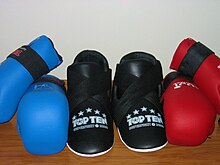There are two kinds of competition sparring: point sparring, in which all strikes are light contact and the clock is stopped when a point is scored; and Olympic sparring, where all strikes are full contact and the clock continues when points are scored. Sparring involves a Hogu, or a chest protector, which muffles any kick's damage to avoid serious injuries. Helmets and other gear is provided as well. Though other systems may vary, a common point system works like this: One point for a regular kick to the Hogu, two for a turning behind kick, three for a back kick, and four for a spinning kick to the head.
World Taekwondo Federation

Official WTF trunk protector (hogu), forearm guards and shin guards
Points are awarded for permitted, accurate, and powerful techniques delivered to the legal scoring areas; light contact does not score any points. The only techniques allowed are kicks (delivering a strike using an area of the foot below the ankle) and punches (delivering a strike using the closed fist).[39] In most competitions, points are awarded by three corner judges using electronic scoring tallies. Several A-Class tournaments, however, are now experimenting with electronic scoring equipment contained within the competitors' body protectors. This limits corner judges to scoring only attacks to the head. Some believe that the new electronic scoring system will help to reduce controversy concerning judging decisions,[40] but this technology is still not universally accepted.[41]
Beginning in 2009, a kick or punch that makes contact with the opponent's hogu (the body guard that functions as a scoring target) scores one point. (The trunk protector is referred to as a momtong pohodae 몸통 보호대 or trunk guard in the WTF rules.) If a kick to the hogu involves a technique that includes fully turning the attacking competitor's body, so that the back is fully exposed to the targeted competitor during execution of the technique (spinning kick), three points are awarded. A kick to the head scores three points; as of October 2010 an additional point is awarded if a turning kick was used to execute this attack.[42] Punches to the head are not allowed. As of March 2010, no additional points are awarded for knocking down an opponent (beyond the normal points awarded for legal strikes).
The referee can give penalties at any time for rule-breaking, such as hitting an area not recognized as a target, usually the legs or neck. Penalties are divided into "Kyong-go" (warning penalty) and "Gam-jeom" (deduction penalty). Two "Kyong-go" are counted as an addition of one point for the opposing contestant. However, the final odd-numbered "Kyong-go" is not counted in the grand total.[43]
At the end of three rounds, the competitor with most points wins the match. In the event of a tie, a fourth "sudden death" overtime round, sometimes called a "Golden Point", is held to determine the winner after a one-minute rest period. In this round, the first competitor to score a point wins the match. If there is no score in the additional round, the winner is decided by superiority, as determined by the refereeing officials.[42] or number of fouls committed during that round.
Until 2008, if one competitor gained a 7-point lead over the other, or if one competitor reached a total of 12 points, then that competitor was immediately declared the winner and the match ended. These rules were abolished by the WTF at the start of 2009. In October 2010 the WTF reintroduced a point-gap rule, stating that if a competitor has a 12-point lead at the end of the second round or achieves a 12-point lead at any point in the third round, then the match is over and that competitor is declared the winner.[42]
USA Taekwondo is the officially recognized National Governing Body for Taekwondo for the United States Olympic Committee (USOC), and the official Member National Association of the World Taekwondo Federation.
International Taekwon-Do Federation
The International Taekwon-Do Federation's sparring rules are similar to the WTF's rules, but differ in several aspects.- Hand and foot attacks to the head are allowed.[44]
- The scoring system is:
- 1 point for: Punch to the body or head.
- 2 points for: Jumping kick to the body or kick to the head
- 3 points for: Jumping kick to the head
- The competition area may vary between 10×10 meters and 20×20 meters in international championships.
A continuous point system is utilized in ITF competition, where the fighters are allowed to continue after scoring a technique. Excessive contact are generally not allowed according to the official ruleset, and judges penalize any competitor with disqualification if they injure their opponent and he can no longer continue (although these rules vary between ITF organizations). At the end of two minutes (or some other specified time), the competitor with more scoring techniques wins.
Fouls in ITF sparring include: attacking a fallen opponent, leg sweeping, holding/grabbing, or intentional attack to a target other than the opponent.[45]
ITF competitions also feature performances of patterns, breaking, and 'special techniques' (where competitors perform prescribed board breaks at great heights).
Other organizations
American Amateur Athletic Union (AAU) competitions are very similar, except that different styles of pads and gear are allowed.[46]Apart from WTF and ITF tournaments, major taekwondo competitions (all featuring WTF taekwondo only) include:
WTF taekwondo features in all multi-sport games except the Small Island Games. It was accepted as a Commonwealth Games sport in June 2010.

Tidak ada komentar:
Posting Komentar